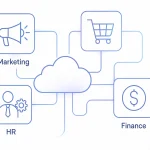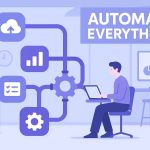Automation in Finance: How RPA is Transforming Accounting and Reporting

Introduction
Automation in finance is revolutionizing how businesses manage accounting, reporting, and compliance processes. As organizations strive for greater accuracy, speed, and efficiency, Robotic Process Automation (RPA) has emerged as a powerful ally in transforming traditional finance operations. From automating data entry to generating real-time financial insights, RPA is reshaping the financial landscape for businesses of all sizes.
What is RPA in Finance?
Robotic Process Automation (RPA) is a technology that uses software robots to automate repetitive, rule-based tasks that were traditionally performed by humans. In finance, RPA helps automate key processes such as transaction processing, reconciliations, report generation, and compliance checks. By doing so, it reduces manual errors, saves time, and ensures data consistency across systems.
Why Automation Matters in Financial Operations
The finance department is often burdened with repetitive, high-volume tasks — data entry, invoice processing, account reconciliation, and regulatory reporting. These tasks are prone to human errors and consume valuable time that could otherwise be spent on strategic decision-making. Automation allows finance professionals to focus more on analysis and forecasting rather than manual processing.
Key Benefits of RPA in Accounting and Reporting
- Increased Accuracy: RPA bots eliminate manual data entry errors, ensuring higher data reliability for audits and reports.
- Faster Processing: Financial transactions, reconciliations, and reporting can be completed in minutes instead of hours.
- Improved Compliance: Automation ensures consistent application of financial policies and creates auditable trails for all transactions.
- Cost Reduction: Reduced manual effort and faster operations translate to significant savings in operational costs.
- Enhanced Productivity: Finance teams can focus on insights, forecasting, and strategy rather than repetitive tasks.
Core Use Cases of RPA in Finance and Accounting
1. Invoice Processing
Manual invoice handling is slow and error-prone. RPA can automatically read invoice data using OCR (Optical Character Recognition), validate it against purchase orders, and process payments through accounting systems like QuickBooks or SAP. This drastically reduces approval cycle times and ensures timely vendor payments.
2. Bank Reconciliation
Financial teams spend countless hours reconciling bank statements. RPA bots can fetch transaction records, match entries, and flag discrepancies automatically. This ensures accurate daily reconciliations without manual oversight.
3. Financial Reporting
Preparing monthly, quarterly, and annual financial reports involves collecting and consolidating data from multiple systems. With RPA, data can be extracted, validated, and formatted automatically into standard reporting templates — ensuring accuracy and consistency.
4. Payroll Processing
Payroll management requires handling sensitive employee data, deductions, and compliance calculations. RPA ensures timely salary processing, tax deductions, and reporting without human intervention — enhancing both security and reliability.
5. Tax and Compliance Management
Finance teams often struggle to stay updated with changing tax regulations. RPA helps by automating tax data collection, validating compliance requirements, and generating audit-ready reports. This minimizes compliance risks and avoids penalties.
6. Accounts Payable and Receivable Automation
RPA ensures seamless coordination between invoices, payments, and receipts. For instance, bots can automatically send reminders for overdue payments or process incoming receipts into the ERP system without human involvement.
How RPA is Changing the Role of Finance Professionals
RPA is not replacing finance professionals — it’s augmenting their capabilities. By automating repetitive work, accountants and analysts can focus on tasks that require human judgment, such as financial analysis, forecasting, and risk management. The shift from manual operations to strategic decision-making is enhancing the overall value finance teams bring to organizations.
Integration of RPA with AI and Machine Learning
While RPA excels at handling rule-based processes, its true potential unfolds when combined with Artificial Intelligence (AI) and Machine Learning (ML). AI can help analyze large financial datasets, detect anomalies, and predict cash flow trends — while RPA executes actions based on these insights.
This combination is leading to Intelligent Process Automation (IPA) — a next-generation approach where bots not only perform tasks but also learn and adapt to improve outcomes over time. For example, AI-powered bots can identify fraudulent transactions by detecting unusual patterns in financial data.
Real-World Examples of Finance Automation
- American Express: Uses RPA to automate reconciliation and customer onboarding processes, improving compliance and reducing operational costs.
- Deloitte: Implemented RPA for client accounting services, automating report generation and reducing manual errors.
- UiPath Clients: Many enterprises leverage UiPath bots for automating tax filings, expense management, and reporting workflows, achieving ROI within months.
Challenges in Implementing RPA in Finance
While RPA delivers immense value, businesses often face challenges during adoption:
- Process Complexity: Some financial processes involve judgment-based tasks that are hard to automate without AI integration.
- Change Management: Finance teams may resist automation due to job security concerns or lack of training.
- Integration Issues: Legacy accounting systems may require APIs or connectors to enable smooth automation.
- Maintenance: Bots need to be updated when financial rules, tax laws, or systems change.
Best Practices for Successful RPA Implementation in Finance
- Start with high-volume, low-complexity processes like reconciliations and reporting.
- Use centralized monitoring to track bot performance and prevent errors.
- Ensure strong governance, compliance checks, and security protocols.
- Combine RPA with AI for intelligent decision-making and predictive analytics.
- Partner with experienced automation consultants like Deca Soft Solutions to ensure a smooth transition.
Future of RPA in Financial Reporting and Accounting
The future of finance automation lies in hyperautomation — the end-to-end integration of RPA, AI, ML, and analytics. In this future, bots will handle not only repetitive tasks but also cognitive processes like decision-making, forecasting, and fraud detection. Financial data will be processed in real time, allowing CFOs to access live dashboards instead of static monthly reports.
As per a Deloitte report, nearly 80% of financial leaders plan to increase automation investments by 2026. This shift signals that automation is no longer optional — it’s a strategic necessity.
Conclusion: Driving Financial Excellence Through RPA
RPA is redefining the financial world by making accounting and reporting faster, smarter, and more reliable. Whether it’s automating invoices or delivering AI-driven insights, finance automation is empowering businesses to achieve operational excellence and informed decision-making.
At Deca Soft Solutions, we help organizations leverage RPA and AI to modernize financial workflows, reduce costs, and improve compliance. To learn more, explore our blog on RPA vs AI: How They Work Together or contact us for a tailored automation strategy.




